
Chatham Grove Elementary School plans to punish students for reports of “homophobic” and “xenophobic” behavior in K-5; Chatham County Schools provides teachers with learning material specifically mentioning “Critical Race Theory”
Incidents
Parents Defending Education received a letter that the principal of Chatham Grove Elementary School emailed to parents on March 23, 2022. The principal wrote in the email:
I am writing to let you know that Chatham County Schools has updated student disciplinary consequences for reports and incidents involving racial, homophobic or xenophobic behavior. This includes comments as well as actions.
The principal then listed consequences for perceived “use of racial, homophobic or xenophobic epithets, or bullying or harassment that was racial, homophobic or xenophobic” for “grades k-5”:
- 1st offense will result in a 3-day suspension and required participation in restorative circles upon return.
- 2nd offense will result in a 5-day suspension, administrative school reassignment and required participation in restorative circles upon return.
- 3rd offense will result in a 10-day suspension, recommendation for long-term suspension and required participation in restorative circles upon return.
Parents who contacted us raised concerns about how poorly defined these potential offenses are. Would a child asking why they can say ‘Black Lives Matter’ but not ‘Blue Lives Matter’ be in violation of this policy? What if they simply shared their personal opinion that ‘marriage should be between a man and a woman’ or that ‘too many immigrants are coming across the southern border?’
On March 24, 2022, students in the elementary school received presentations on the new rule. These presentations were provided to parents later that day in an email. In the presentation for students in kindergarten through second grade, the book All Are Welcome was discussed in classrooms. Children were asked the following questions about the book:
- Do all of the people in the story look the same?
- Do they all like the same things or come from the same place?
- How should we treat others who are different from us?
In the presentation for students in the third grade through the fifth grade, the book We’re All Wonders was discussed in classrooms. The presentation then states that students should not “tease” or “make unkind comments” about other children based on “someone looking different from us (someone’s race or skin color),” “someone’s gender,” and “someone’s culture/beliefs/religion.”
On March 14, 2022, Chatham Grove Elementary School’s district – Chatham County Schools – adopted a new policy on discrimination and harassment. The school district states in the policy:
When students and staff use or experience racial insults, slurs, and/or other hate speech, we lack the positive culture and climate that support students’ growth.” The policy states numerous actions that will be taken “If an issue of racial slurs, hate speech or a related incident occurs, or is reported.
One action is to “identify the current and future impact of the harm done and leverage support of the school-based equity team and the district’s staff for the use of student/faculty focus groups, restorative circles, or restorative conferences, as appropriate.” Another action is to “identify community or central office support that may offer ongoing school improvement” and “develop an after-incident plan of action to include restorative practices and other in-school opportunities for reconciliation and community building.”
The school district has a website dedicated to equity titled “Equity and Excellence for Everyone.” The homepage of the website promotes naming staff as “Equity Champions.” The website states:
We have so many folks in our school district who are fierce champions for students. They work to eliminate barriers in the classroom, in their schools, and in our community. If you have any staff members who are consistently on the frontlines, advocating for best practices, and supporting our most marginalized students, please nominate them below. They will receive district recognition and a special price.
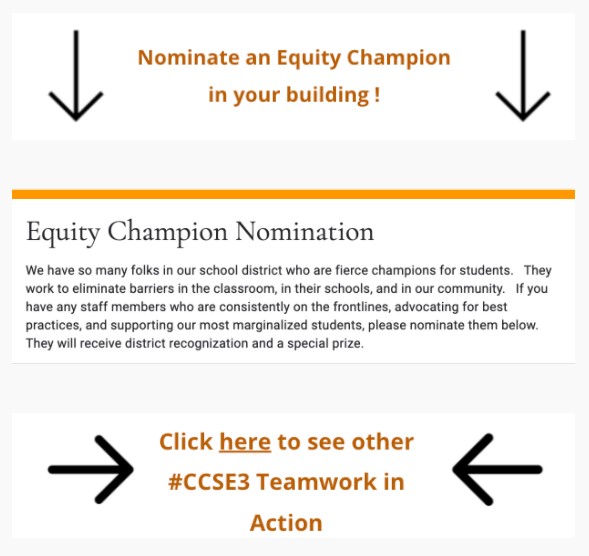
The equity website appears to state that the school district’s mission is to turn students into political activists. The website’s mission page states that the district intends to “support students in reaching their potential by advocating for social justice, eliminating barriers for diverse populations, and utilizing culturally relevant resources while ensuring equity is embedded in all areas of our district’s culture.” The mission page then lists the beliefs of the school district:
- We believe we must engage our stakeholders in better understanding the inherent historical, institutional, and cultural aspects of racism and discrimination.
- We believe that it is imperative to understand the significant difference between equity and equality.
- We believe every student deserves to be respected and receive what he/she needs to be successful.
- We believe developing a deeper understanding of our students’ traditions & cultures and recognizing our similarities and differences will bring understanding to our community.
- We believe that a student’s race, gender, disability, sexual orientation, ethnicity, or legal status should not determine his/her potential.
- We believe our district and our community should serve as advocates for all children regardless of their background or circumstances.
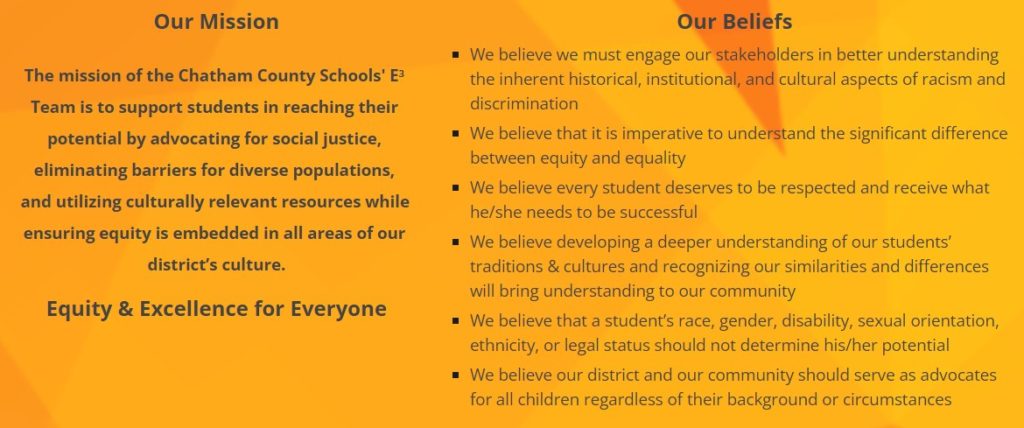
On a page labeled “E3 Team Projects,” the school district promotes that it has involved students in equity initiatives. The page mentions that “in December of 2017 the CCS E3 Team hosted the first student equity focus groups.” The page then continues to explain that the school district “talked to students at each of our traditional high schools about race, culture, social justice, and other topics impacting our youth.”

The school district’s equity website also has a page titled “Equity Report Cards.” A 2017 report states: “There are many causes of racial disproportionality including, but not limited to, implicit racial bias of decision-makers, institutional and structural racism, and explicit discrimination against people of color.” The report separated student data based on race.
The school district’s equity website has a document titled “Overview of Chatham County School’s Equity Professional Development.” The page explains what training the school district has for staff. Topics for these training sessions include “equity roundtables,” “culturally responsive classrooms,” “affinity groups,” “racial equity,” and “supporting transgender students and LGBTQ youth.” The term “culturally responsive” is often used to describe a method of teaching that includes the race and ethnicity of students as part of the lessons taught in classrooms. “Affinity groups” are segregated groups that typically separate staff or students by race or another identity attribute.
In an “Affinity Group” presentation attached to the document on equity training, affinity groups are described “as a ‘safe space’ where everyone in the group shares a particular identity.” The presentation continues to explain that “the identity can be based on race, gender, sexual orientation, language or nationality and other indicators.” The presentation then explains that an affinity group “helps to create positive affirmation of identity and builds capacity for learning.”
The presentation also provides examples of affinity groups that include “faith/religion based,” “family structure,” “LGBTQIA+,” and “race/ethnicity based groups.” The school district explains in the presentation that “student survey data” can be used to help start an affinity group. The presentation then names examples of affinity groups in the school district. These include “Pride/Gay Straight Alliance” and “Orgullo Latinx Pride.” The presentation tells staff to “ask for permission to visit meetings” and “don’t just assume it’s ok to show up.”
The presentation teaches staff how to resist pressure when other staff who disagree with affinity groups “push back.” The presentation then encourages staff to ask questions to other staff who disagree with affinity groups. One question is: “Are there groups that you belong to?” One of the examples of an answer is “church.”
In another training presentation from March 2019 attached to the equity training document, teachers are asked about their “equity and culturally proficient practices.” One question asked to teachers is: “What go to resources do you use to help create a culturally responsive classroom (e.g., videos, articles, texts)?” Another questioned asked is: “Often times groups are portrayed inaccurately in curricula. Why is it necessary for an educator to counter stereotypes or myths about groups of people with facts?”
A “Culturally Proficient Classroom Rubric” from the 2015-2016 school year attached to the equity training document asks teachers how they implement equity into their classrooms. Teachers are asked if the following are implemented into their lesson plans:
- Guide students in examining bias and stereotypes related to language, culture, ethnicity, faith, gender, economic status, etc.
- Read aloud books that are representative of the varied races in the room.
- Classroom libraries are rich with texts, resources and learning materials that reflect diversity of culture, ethnicity, faith, and language, and differences in socioeconomic status, physical ability and family structure.
- Classroom and hallway displays reflect gender and racial balance. They mirror the diversity of the community and the world outside the classroom.
An article attached to the equity training document is titled “Barriers to Good Instruction.” This article states: “Despite much progress in U.S. society during the past few decades, racism and prejudice are still ugly realities in all sectors of American life, including education.” At one point, the article outright states that “a teacher can make classwork more relevant for children by using illustrations and examples linked to their culture or race.”
The school district’s website has a “Toolkit and School Resources” page that features a document titled “Equity Toolkit for Administrators and Schools 2021-2022.” The document has several goals for schools in the district:
- For the 2021-2022 school year, all schools require teachers to have an equity goal for their Professional Development Plans.
- Schools will work on identifying school-wide areas of focus in regards to equity and culturally responsive classrooms and work to address these areas in the School Improvement Plans.
- Carry out [professional development] provided by the district in the time frame requested.
The document also shows holidays and equity events that the school district will celebrate. These include “LGBTQ+ History Month” and “LGBTQ+/Pride Month.” In an attached document titled “School Level Actions Steps for Embedding Equity in School Improvement Planning,” the school district states that teams are developing “standards-aligned units of instruction for each subject and grade level.” The following are then listed as potential action steps:
- District E3 team will provide professional development where all staff members will better understand culturally relevant teaching.
- PLCs will discuss culturally relevant teaching strategies, and work to implement strategies into lesson plans/units.
- Administration will monitor plans in PlanBook and give feedbacks in regards to culturally relevant text selection.
- Unit plans for each EOC core academic areas and CTE will include culturally relevant text and instructional strategies.
The “Equality Toolkit” document also has a section called “LGBTQ Resources” that links to the organization “Safe Schools NC.” The organization’s website explains that Safe Schools NC “believes that educating other educators about LGBTQ+ issues and inclusive learning environments is one of the best ways to make schools welcoming for all students.”
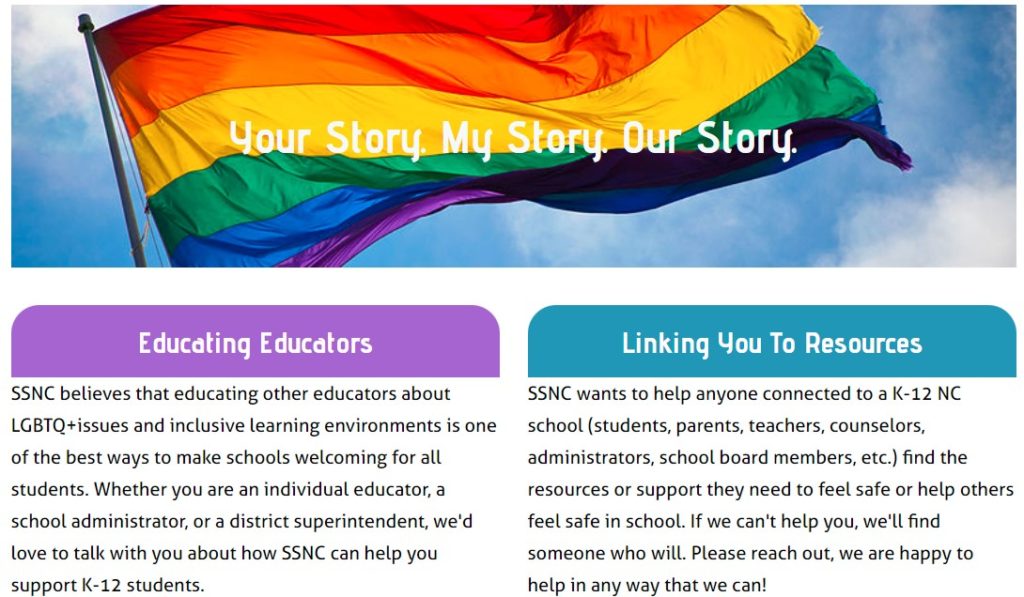
Safe Schools NC has a page on its website that provides LGBTQ resources for students, parents, and teachers. One resource is called the “Dos and Don’ts for Working with Transgender Students.” The resource contains several guidelines for teachers that include:
- Add “Name you want to be called” and “Pronouns” to student info sheets at the beginning of the semester.
- Call the student (and all students) by the name and pronouns they prefer. This is the quickest way to help a transgender student feel safe and welcome.
- Correct other students in your classroom if they use the wrong name or pronoun.
- Remember that for a trans student to use the bathroom they are currently allowed to use and feel safe in (single stall), they often have to go out of their way in the building and might be rushed or late to class. Work with the student to come up with a fair and caring solution to this issue.

Another resource that Safe Schools NC promotes is called the “Teaching Transgender Toolkit.” The description of the toolkit explains that it is “a collection of 30 lesson plans designed to support facilitators in implementing impactful Transgender 101+ Trainings.” Safe Schools NC also promotes the “Gender Unicorn” that schools have used in an attempt to teach children that gender is on a spectrum.

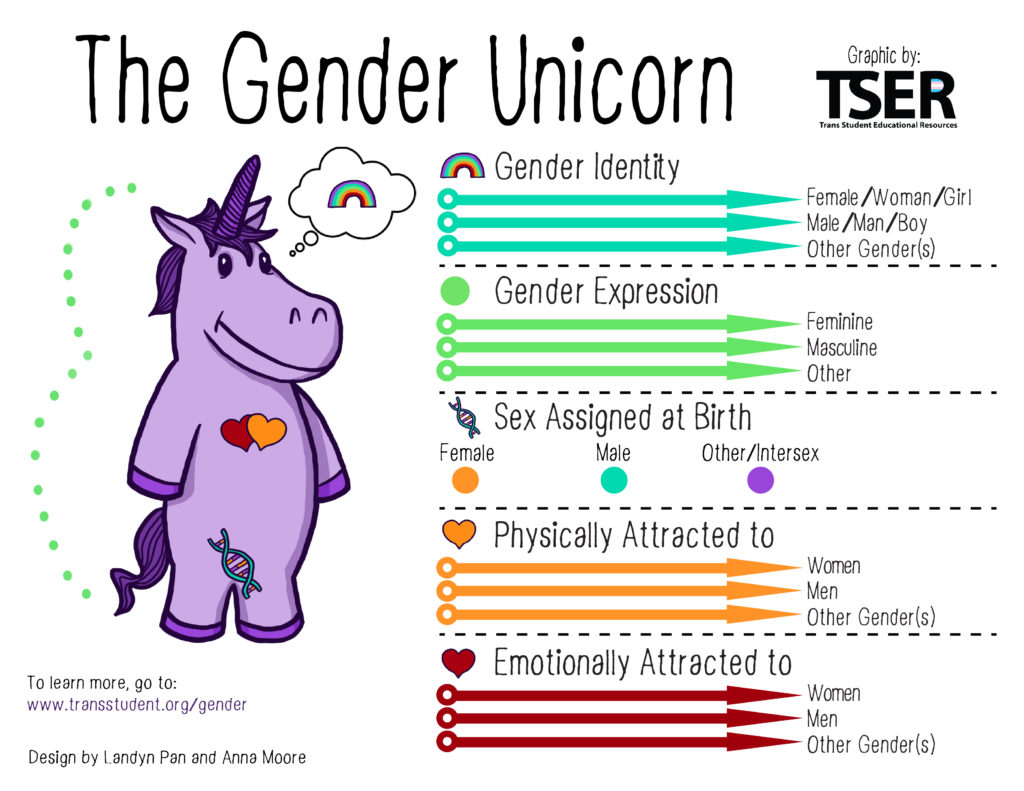
The “Toolkit and School Resources” page on the school district’s equity website also has a document titled “CCS E3 Black History Month Resources” that provides teachers with resources for Black History Month. One resource on this document is from the “We Are Teachers” organization and encourages educators to teach students about the Black Lives Matter movement. Several resources for teachers on the document are from the organization Learning for Justice.
Learning for Justice is known for pushing its “Social Justice Standards” in schools throughout the country. The document for these standards includes goals to achieve for students. One goal is that “students will develop language and historical and cultural knowledge that affirm and accurately describe their membership in multiple identity groups.” Another goal appears to outright state that the purpose of the “Social Justice Standards” is to turn students into political activists: “Students will make principled decisions about when and how to take a stand against bias and injustice in their everyday lives and will do so despite negative peer or group pressure.”
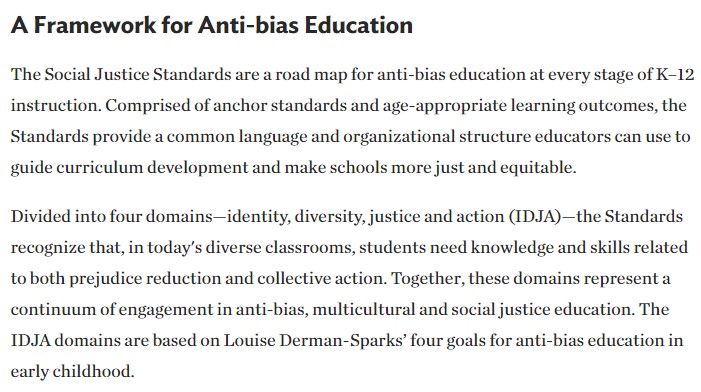
The equity website’s resources page also links to another page labeled “Video Resources.” One video on the page is titled “Equity vs. Equality.” The video attacks the idea of “equality” in education. Another resource on this page links to a New York Times article with videos titled “A Conversation About Growing Up Black,” “A Conversation With White People on Race,” and “A Conversation with Police on Race.” One resource on the New York Times article is even titled “Confronting Racist Objects.”

The equity website’s resources page has a link to another page titled “Reading Resources.” Articles on this page include “25 mini-films for exploring race, bias and identity with students,” “Struggle in the shadows: book paints grim future for undocumented young adults,” and “The state of teacher diversity in American education.” One article is titled “White America’s racial illiteracy: Why our national conversation is poisoned from the start” from known political activist Robin DiAngelo. In this article, she has a list of “challenges that trigger racial stress for white people” that includes:
- Suggesting that a white person’s viewpoint comes from a racialized frame of reference (challenge to objectivity).
- People of color talking directly about their own racial perspectives (challenge to white taboos on talking openly about race).
- People of color choosing not to protect the racial feelings of white people in regards to race (challenge to white racial expectations and need/entitlement to racial comfort).
- A fellow white not providing agreement with one’s racial perspective (challenge to white solidarity).
- Suggesting that group membership is significant (challenge to individualism).
- Being presented with a person of color in a position of leadership (challenge to white authority).
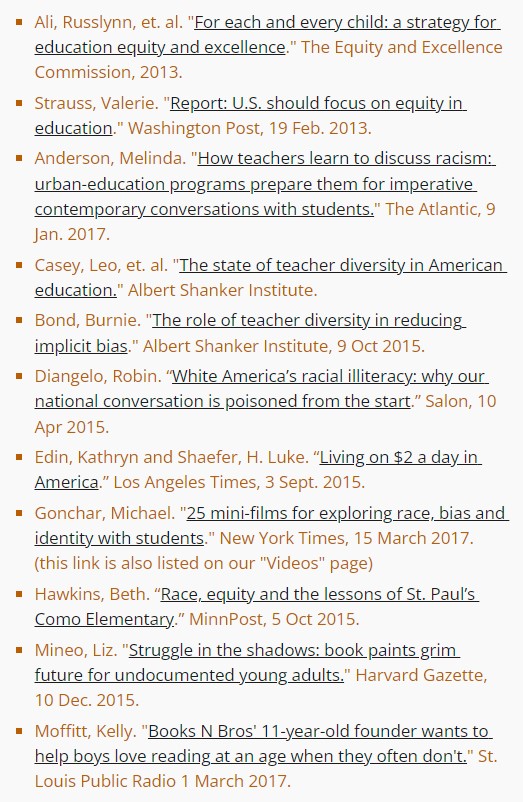
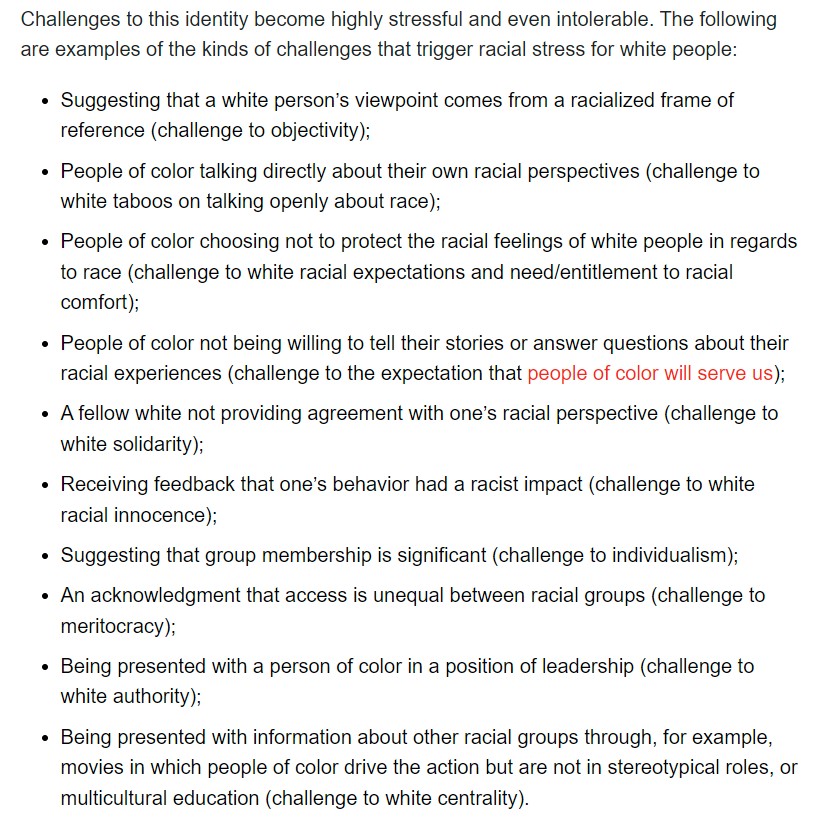
The school district’s equity website also has a page labeled “Community Organizations.” The known political organization American Civil Liberties Union (ACLU) is listed on the page. The school district additionally lists the LGBTQ groups “LGBT Center of Raleigh” and “Equality North Carolina.”
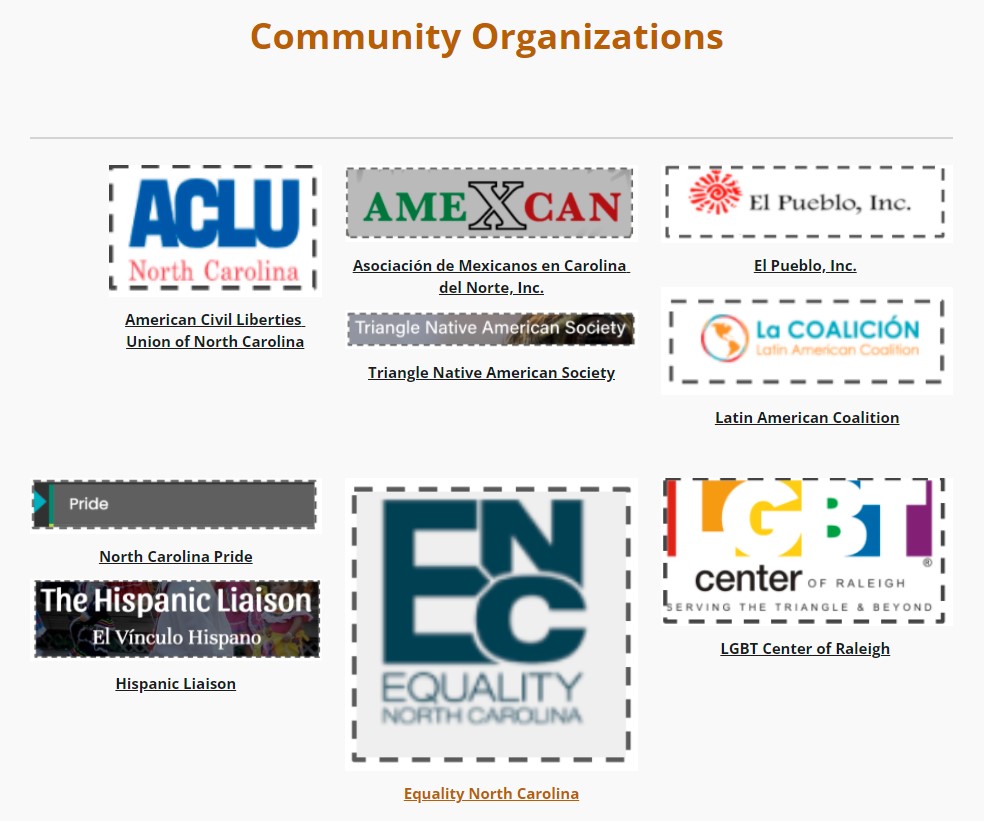
The school district’s equity website has a page titled “E3 Team Symbaloo.” The school district explains: “The following Symbaloo page was developed by a UNC Doctoral Class as a part of their internship class. The class curated equity related resources for the equity team to utilize to further the work across the district.” The school district’s “symbaloo” is an interactive diagram with squares that educators can click on in order to learn more about the topic of that specific square. The equity website’s page specifically explains that this “symbaloo” was created for the school district.
Two squares on this diagram are titled “Critical Race Theory” and “Critical Race Theory 2.” One video in the “Critical Race Theory” sqaure is titled “EDTalks: Dr. Keith Stanley Brooks ‘Critical Race Theory – Fact vs. Feeling.'” The host of the video complains about perceived “whiteness.” Another video is titled “Critical Race Theory and Education.” In this video, the speaker explains the tenets of Critical Race Theory (CRT) that include “racism is normal, not aberrant in U.S. society,” “stories or counter-narratives are useful in explaining how racism operates,” and “employs critical social science.” [Time Stamp: 6:20]

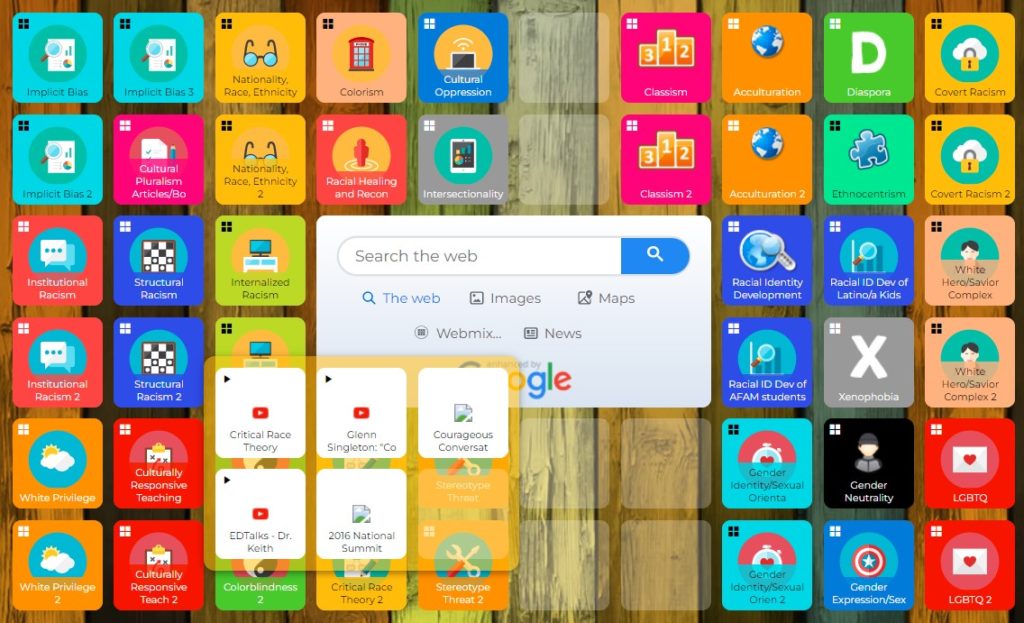
The “Critical Race Theory 2” square promotes a resource that links to the article “Images and Words that Wound: Critical Race Theory, Racial Stereotyping, and Teacher Education.” Another resource linked in the “symbaloo” is titled “Foundations of Critical Race Theory in Education.” The abstract of this resource states: “More recently, CRT has proven an important analytic tool in the field of education, offering critical perspectives on race, and the causes, consequences and manifestations of race, racism, inequity, and the dynamics of power and privilege in schooling.” Additional resources in the “symbaloo” include a paper titled “Critical Race Studies in Education: Examining a Decade of Research on U.S. Schools” and “Just what is critical race theory and what’s it doing in a nice field like education?“





Additional resource squares in the school district’s “symbaloo” include the topics “Implicit Bias,” “Institutional Racism,” “White Privilege,” “Culturally Responsive Teaching,” “Internalized Racism,” “Intersectionality,” “Covert Racism,” “Racial Identity Development,” “White Hero/Savior Complex,” “Gender Identity/Sexual orientation,” and “LGBTQ.”

The school district’s equity website has a page titled “Teaching Tools and Helpful Links.” One resource is titled “How to be a Student Activist.” The resource explains in-depth how students can become political activists. This resource then provides examples and additional resources to assist students in participating in controversial political movements, including Black Lives Matter and “LGBTQ and Gender Equality.” The resource then explains a perceived success story:
In 2016, North Carolina passed a law mandating that people must use the bathroom of the biological sex they were born with, regardless of the gender they identify with. The University of North Carolina system announced it would adhere to the state law in April, resulting in waves of protests at appearances by the university president as well as sit-ins at campus bathrooms and administration buildings. By May, the university said it would not enforce the law.
Additional resources include links to the political organizations Learning for Justice, Zinn Education Project, Congress on Racial Equity, Racial Equity Institute, Rethinking Schools, and Teachers for Social Justice.
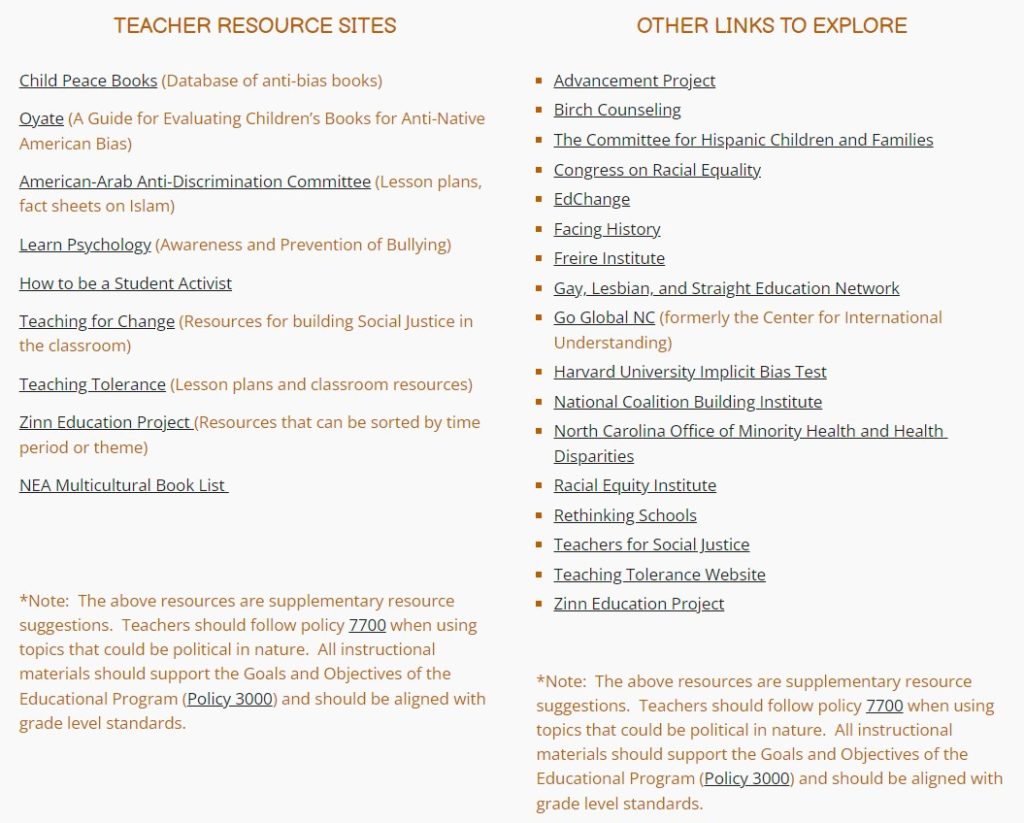

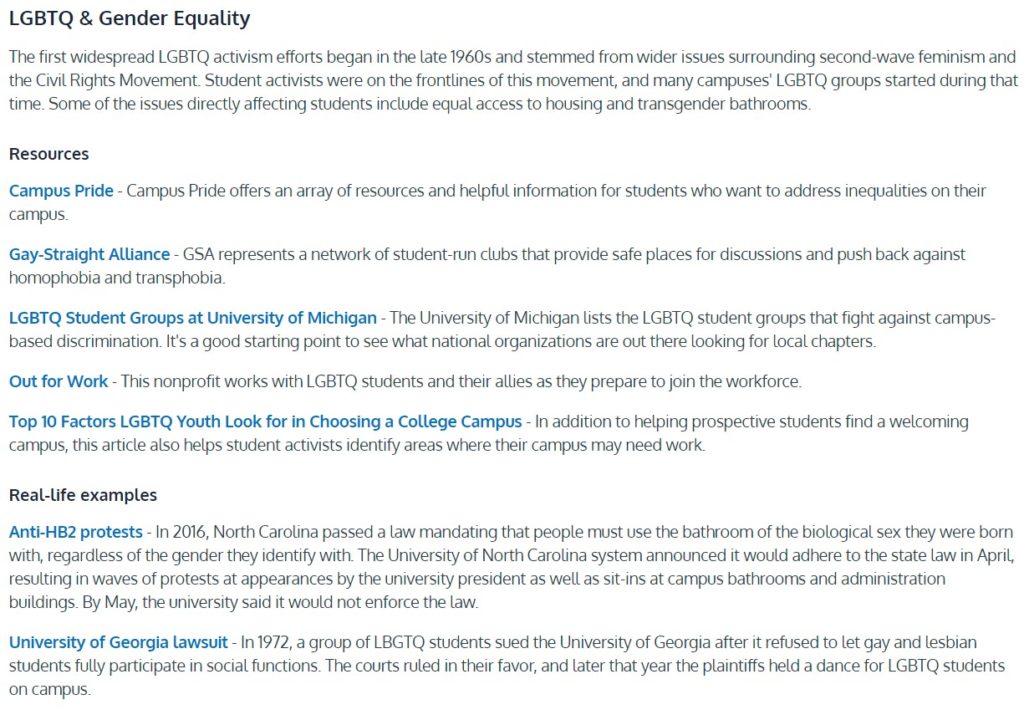
Stay Informed
